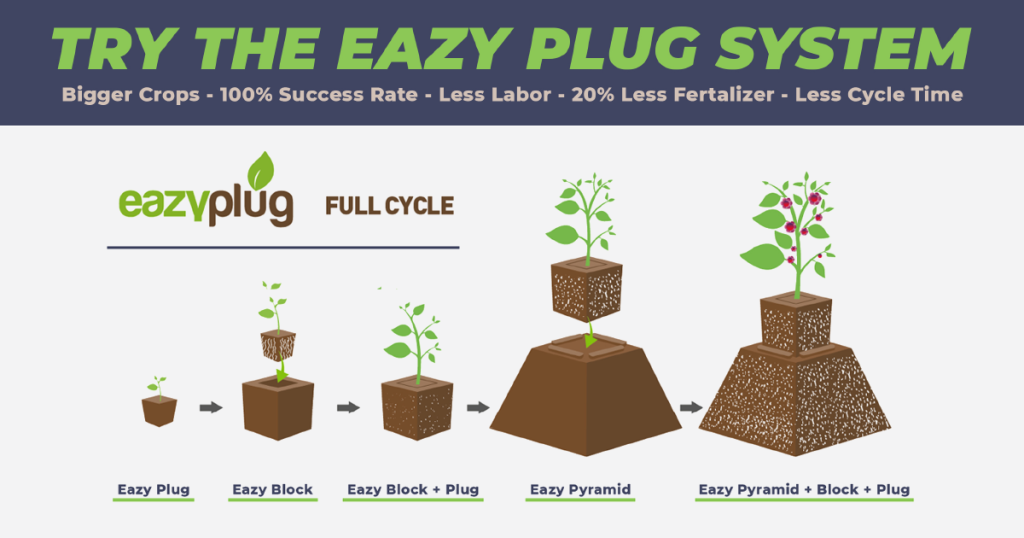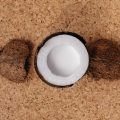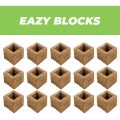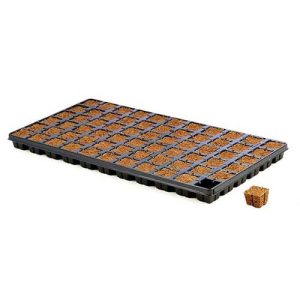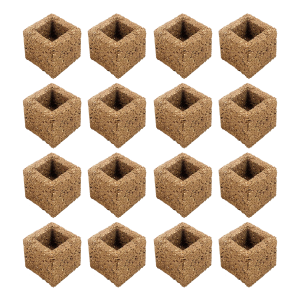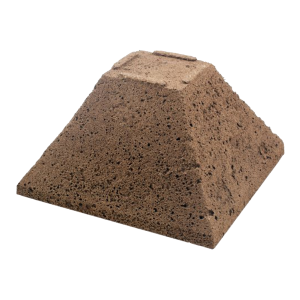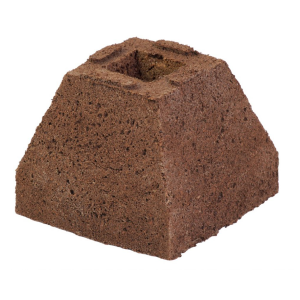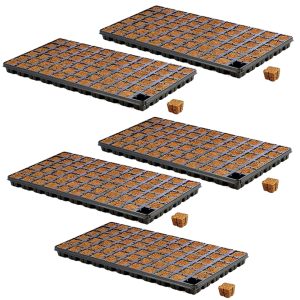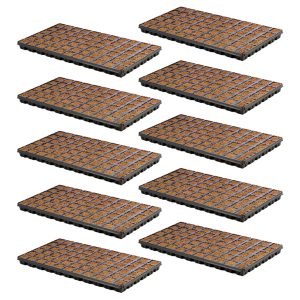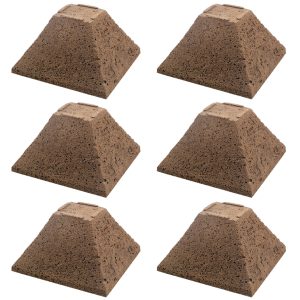Quick Reference:
How to Use Eazy Plugs for Seed Propagation
How to Use Eazy Plugs for Cuttings / Cloning
Eazy Block Instructions
Eazy Pyramid Instructions
How to Use Eazy Plugs for Seed Propagation:
Step 1: Moisten Eazy Plug
Allow the Eazy Plugs to fully suck up water with a pH of 5.8.
Let it drain out excess water. Do not squeeze out or dry the plugs. Eazy Plugs are self-regulating and will only hold the water they need for an optimum moisture level and an optimum air-to-water ratio. The plug will feel much heavier than Rock-Wool, but that’s normal.
Step 2: Sowing
Plugs with seed gap: Place the seed into the preformed seed gap. Cover the plug (including seed gap) with a thin layer of top soil (Eazy Mixx) of 1-2 mm. Cautiously spray water on top of top layer soil to moisten it thoroughly en to ensure a moistened seed and top layer soil.
Plug with cutting hole: In case of a cutting hole ensure the seed is not too deep and do not press it in too deep. You can break off a small corner of the plug and put it into the top of the hole to cover the seed, but that should never be more than a layer of about 5 mm. For most seed types this covering is not a necessity. After sowing, sprinkle the plug shortly with some water, to ensure the seed is wet.
Step 3: Put into propagator
Put the tray with sown Eazy Plugs into a propagator.
Close the lid of the propagator and shut any present air vents to keep the humidity inside the system.
Step 4: Assure drainage of excess water
Make sure Eazy Plug is able to drain excess water at all times, so it can always self-regulate the correct amount of moisture. Never let the bottom of the Eazy Plug touch water, as the moisture absorption of Eazy Plug is exceptionally good and the Eazy Plug will quickly become too wet, which will have a negative effect on the rate of success.
Step 5: Await germination
Until the first appearance of a seedling, you should always keep the Eazy Plug moist enough. The Eazy Plug itself contains sufficient moisture for germination and with the use of a completely closed propagator the moisture remains into the system and the Eazy Plug and seeds are not likely to dry in those first few days. Loss of moisture caused by an open lid or air vent can cause rapid dehydration, which can seriously effect your success rate.
Step 6: Open air vents
Once seeds have germinated and a seedling has grown, one can gradually open the air vents in order to acclimate the seedling to a less humid environment.
Step 7: Transplant
After germination the seedling will quickly grow its roots through the Eazy Plug. When the first roots have become visible, it is time to transplant your plug with seedling.
Germination conditions:
1. Temperature: The optimum soil temperature for germinating seeds is 20-25 degrees Celsius. However, make sure that the seed itself is no warmer than 25 degrees Celsius. Take into account that most lamps generate radiant heat which raises the temperature of the seed itself to a higher level than the temperature of the air or soil. To avoid any risk, a seed temperature of 22-23 degrees Celsius is advisable. Above 25 degrees Celsius, you must consider a serious failure rate for most seed varieties.
2. RH (humidity): RH of min. 80% is perfect for the seeds and Eazy Plug to not dry out.
3. Light: In general there are not a lot of seed varieties where light is an absolute requirement for germination. For most seed types, the application of an additional light source will only lead to a risks of excessive heat development of the seed (radiant heat) and dehydration of both seed and plug. Just daylight or even a dark room situation will be OK for most seed types to germinate. Should you decide to put in an additional light source, then realize that most seeds only need very little light of a certain color.
How to Use Eazy Plugs for Cuttings / Cloning:
Step 1: Moisten the Eazy Plug
Allow the Eazy Plugs to fully suck up water with a pH of 5.8.
Let it drain out excess water. Do not squeeze out or dry the plugs. Eazy Plugs are self-regulating and will only hold the water they need for an optimum moisture level and an optimum air-to-water ratio. The plug will feel much heavier than Rock-Wool, but that’s normal.
Step 2: Take cutting
For a more detailed explanation of taking cuttings click here.
Cut diagonally at a 45 degree angle just below a node or stem swelling, making sure to keep at least 3 nodes above your intersection.
Remove all but a couple of leaves. Scrape a little of the outer layer at the bottom of the cutting, but not all around. Cut off ⅓ of the top of remaining big leaves.
Step 3: Root stimulator
If you want to make use of a rooting powder (for example Rhizopon), dip the base of your fresh cut cutting into the rooting powder.
Step 4: Insertion in Eazy Plug
Insert the cutting into the Eazy Plug cutting hole. Make sure to insert it deeply enough, completely to the bottom of the cutting hole.
Step 5: Put into propagator
Put the tray with Eazy Plug into a propagator.
Close the lid of the propagator and shut any present air vents to keep the humidity inside the system.
Step 6: Remoistening and fresh air
Only remoisten the Eazy Plug after 3 days and keep on doing that every 3 days until the first appearance of roots.
Briefly open the propagator every day for a little fresh air.
Open the air vents slightly at the earliest after 4-5 days. Humidity should remain above 80%, as too much loss of humidity can seriously effect your success rate.
Step 7: Assure drainage of excess water
Make sure Eazy Plug is able to drain excess water at all times, so it can always self-regulate the correct amount of moisture. Never let the bottom of the Eazy Plug touch water, as the moisture absorption of Eazy Plug is exceptionally good and the Eazy Plug will quickly become too wet, which will have a negative effect on the rate of success.
Step 8: Open air vents
After the first roots have developed, you can gradually open the air vents further in order to acclimate the cutting to a less humid environment.
Step 9: Transplant
In 7-9 days from start your cutting should have grown its roots throughout the Eazy Plug and it is time to transplant them.
Conditions for developing roots:
1. Temperature: The optimum soil temperature for striking roots is 22º Celsius. Above 23º Celsius, you must consider a rise in failure rate.
2. RH (humidity): RH of 80-95% is perfect. As the cutting needs its energy for striking roots, the moisture level of leaves and stem should remain intact.
3. Light: In the first few days the cutting will form callus, from which the roots will start to grow. In this phase the cutting only needs tempered light with a broad spectrum (regular assimilation light). After the development of roots the amount of light can be gradually increased.
Eazy Block Instructions:
Step 1: Moisten Eazy Block
Prepare water with a pH of 5.8. On personal preference you can add a root stimulator to the water. Allow the Eazy Block to fully suck up the prepared water. Let it drain out excess water. Do not squeeze out or dry the blocks. Eazy Blocks are self-regulating and will only hold the water they need for an optimum moisture level and an optimum air-to-water ratio. The block will feel much heavier than Rock-Wool, but that’s normal.
Step 2: Put plug in block
Put the Eazy Plug with cutting or seedling in the hole on the upper side of the Eazy Block. It will fit nicely and you will not encounter a transplant shock.
Step 3: Remoistening
Only remoisten the Eazy Blocks when they start to show lighter braun spots.
Step 4: Fertilizing
After 5 days start remoistening the blocks with a light fertilizing mix with an EC of 1.2-1.4 and an pH of 5.8.
Step 5: Transplant onto Pyramid
In 8-10 days your young plant should have grown its roots throughout the Eazy Block. By then roots have already started to elongate from the block. It is time to transplant them.
Eazy Pyramid Instructions:
Step 1: Moisten Eazy Pyramid
Prepare water with a pH of 5.8 and an EC of 1.4. Again on personal preference you can add a root stimulator to the water. Allow the Eazy Pyramid to fully suck up the prepared water. Let it drain out excess water. Do not squeeze out or dry the Pyramids. Eazy Pyramids are self-regulating and will only hold the water they need for an optimum moisture level and an optimum air-to-water ratio.
Step 2: Put block onto pyramid
Put the Eazy Block with young plant simply on top of the Eazy Pyramid. It will fit there nicely and will continue developing its roots inside the pyramid without a transplant shock.
Step 3: Remoistening
For quick root development, only remoisten the Eazy Pyramids after 3 days from start and in optimum climate conditions even only after 5 days. Remoistening can be done by all known techniques, like drip-feeding, eb and flow system, manual, etc.
Step 4: Fertilizing
After 5 days start adding a light fertilizing mix to the water up to an EC of 1.2-1.4 and a pH of 5.8.
Step 5: Determine optimum EC
The air pruning effect generates a much more advanced root structure with a much bigger hair root mass and with it an increased uptake capacity. As a result many growers can suffice with an EC value that is +/- 0.2 lower than in older traditional substrates. On first sight of leaves getting lighter green, you should raise the EC immediately back with 0.2. With the Eazy Pyramid material it will take considerably longer for the leaves to grow lighter than with ordinary pots or Rock-Wool, if it already occurs.
Air pruning effect of the Eazy Pyramid
When the tips of the roots grow outside the Eazy Pyramid, they are exposed to relatively dry air because there is no plastic sleeve around the block. This causes the apical cells at the tip of the root to dehydrate, or become air pruned. This effect stimulates the growth of secondary roots, branching out the original roots and growing within the Eazy Pyramid. These secondary roots spread throughout the Eazy Pyramid until again they reach the outer sides where they get air pruned again, stimulating more root growth. The overall air pruninig effect is the establishment of a well-developed root system that is spread evenly throughout the Eazy Pyramid.
No wrapping
Due to its stabilization there is no need for a wrapping, resulting in natural air pruning of the roots growing outside the Eazy Pyramid. This air pruning strongly stimulates the production of new root tips inside the Eazy Pyramid. As a result an Eazy Pyramid will be fully grown with smaller hair roots instead of having a few base roots that grow downwards between growing medium and wrapping like with all conventional blocks. This way there is an abundant root growth inside the entire Eazy Pyramid, making better use of water and nutrition.
No plastic pot
Due to the same strong stabilization there is no need for a plastic pot either. Again offering the advantage of natural air pruning, resulting in a dense mass of hair roots inside the Pyramid. When using a plastic pot, the base roots will grow to the outside, meeting the impermeable wall of the pot and starting to continue their growth alongside the wall of the pot. This results in winding roots or a so called root knot with little to no branching and hair roots. The uptake capacity is therefor incomparable and no match for the Eazy Pyramid.
Eazy Pyramid is self regulating
An Eazy Pyramid has a neutral pH level of 5.5-6.0 and this pH level is buffered. Small deviations can be corrected by the Pyramid. The Eazy Pyramid gets a soft base fertilizer with it. The Pyramid has a pre-determined optimal air-to-water ratio. When the Eazy Pyramid is able to drain out excess water, it will hold the optimum amount of water by itself. Dry cultivation is no problem, the remaining moisture will be evenly divided throughout its material and the Eazy Pyramid always takes water back up easily.
